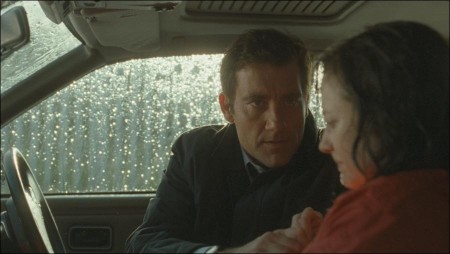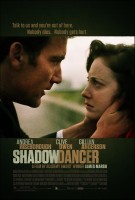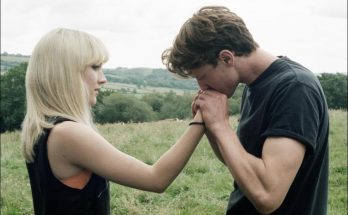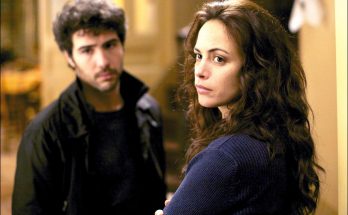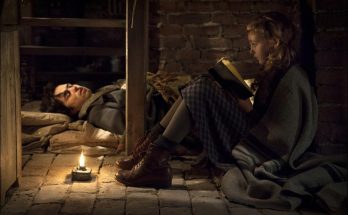Taglines: Collette McVeigh – Mother, Daughter, Sister, Spy.
A conspiracy thriller set around an act of betrayal within a tight knit family, the story centers around single mother Collette McVeigh (Andrea Riseborough) — a Republican living in Belfast with her mother and hardliner IRA brothers. When she is arrested for her part in an aborted IRA bomb plot in London, an MI5 officer (Clive Owen) offers her a choice: lose everything and go to prison or return to Belfast to spy on her own family. With her son’s life in her hands, Collette chooses to place her trust in the MI5 and return home. When her brothers’ secret operation is ambushed, suspicions of an informant are raised and Collette finds both herself and her family in grave danger.
Directed by acclaimed filmmaker James Marsh Magnolia Pictures’ Shadow Dancer stars Andrea Riseborough, Aidan Gillen, Domhall Gleeson, Brid Breenan, David Wilmot, Martin McCann with Gillian Anderson and Clive Owen. Screenplay by Tom Bradby based on his novel.
About the Film (2013)
Adaptation: “That’s your cover story” (Mac)
Shadow Dancer is an intense thriller set in a very real conflict. Its dedication to the facts has furnished the film with powerful, convincing characters set against a compulsive and gripping reality.
From its beginnings as a book written by Tom Bradby during his time as a TV correspondent in Northern Ireland in the 1990s, there has been an honourable intention to dig deep into the heart of the plight. Remarked Bradby: “In a way, writing this book was an opportunity for me to inform people about some aspects of the conflict, like the world of running informers which you couldn’t put on the TV news at night. I built the portrait of the story as a way of telling what was really happening in this war and the real intensity that lay at the heart of it.”
Bradby used his contacts on both sides of the conflict to research the running of agents. “What interested me was the relationship between a male handler and a woman agent: he is effectively trying to keep this woman alive and she is effectively betraying everyone around her in order to try and protect her son, and therefore at some point they become the only point of reality to each other. I thought that was a really interesting idea to lie at the heart of a novel and then a film.”
It was fifteen years after the publication of his novel that Tom Bradby suggested that Chris Coen read Shadow Dancer. From the opening Coen was hooked. “I loved the story of Collette’s journey and the jeopardy she finds herself in when she goes back to Ireland after being given the impossible choice to spend 25 years in prison or become a spy in order to have the opportunity to be with her son and watch him grow up. Immediately I thought that it’s such a powerful thing – it pulls you right into the story. I knew I wanted to option the book.”
Bradby had always had an interest in writing for the screen and was confident about approaching the material for this purpose. “As a novelist I’ve always been used to being brutal with my own work so I took that into screenwriting because you need to be ruthless,” remarked the writer. “The male character [Mac], for example, is quite different from the character in the book who was much younger. For the first few drafts of the script I’d kept him as he was, before realising that it wasn’t working. The whole process of Collette putting her life in this guy’s hands works much better if he is older and a bit more mature, so I killed him off and started again.”
After two years of development, Chris Coen sent the script out to Oscar-winning director James Marsh (Man on Wire, Red Riding, Project Nim). “Every producer has a favourite hit list and James was at the top of mine.” However Marsh says that he picked it up with a heavy heart. “It was about Ireland and the Troubles and we are all glad to have got beyond that, but when I started reading it I realised there was a great premise in the story.”
Although intrigued, at this stage the script had a strong political direction and lots of epic set pieces and Marsh wanted to take it in a new direction. He phoned Coen and pitched his own version. “When he called and I heard his take I was immediately sold,” said Coen. “James pitched a real cinematic experience, one that transcended the politics in order to focus on the thriller aspect and the characters. It was just everything we needed to hear.” As a result the match was made and James came on board the project.
The redrafting started. “I liked the central story of Collette,” said Marsh, “so Tom and I got to work on the script and focussed very much on Collette’s predicament.” Tom Bradby was ecstatic to be collaborating with Marsh. “James is an incredibly insightful, intelligent director. Every time we focussed on a scene that he wasn’t quite happy with or that he thought could be better, the ideas he came up with were perfect and made me think I wish I’d thought of that!”
As the process of honing continued and the story pulled tighter around Collette and her experience, the tale started to take shape as something that felt emotionally driven and far more universal. “We can all try to understand what it’s like to betray our family and betray our own political conviction,” said Marsh, “so the fact that it is set in Northern Ireland at a certain time is a circumstance that allows these things to happen but it’s not really about politics.” This shift in focus attracted financiers. “We won people over because we made a concerted effort to keep the politics as the backdrop of the movie,” he added. BBC Films were the first to come on board, then the BFI (then UKFC) and by the time they stared shooting Paramount had come on board as the UK distributor.
Casting: “This isn’t who you are Collette” (Mac)
Casting Shadow Dancer was a joy. “I think James is just one of those directors that actors want to work with,” said Chris Coen. The integrity and passion with which Marsh works is very appealing to actors and actresses and can be seen in his commanding documentaries Man on Wire and Project Nim. Andrea Riseborough, who plays lead character Collette McVeigh, explains that documentary makers offer something fresh and honest: “They have a very good relationship with reality and so don’t always adhere to usual film protocol when telling the story emotionally and I found that really refreshing.”
With what was essentially an access-all-areas pass, James Marsh had to make his casting choices carefully. Of highest importance for him was authenticity and neither he nor casting director Nina Gold were nervous about stepping off the beaten track to find it. “The two protagonists in the film came later,” said Marsh, “but the first person I cast in fact was Bríd Brennan, who is the mother in the story. I felt this was a really solid way to build the family, around the mother.” The fact that Bríd Brennan grew up in West Belfast during the Troubles was significant to Marsh.
“A lot of our actors were Irish and that was important, firstly because it felt that they knew this world better than I did and I felt they could help me and guide me.” For Brennan the project was particularly resonant since it portrayed a period through which she had lived. “In West Belfast, it was near impossible to remain outside of that conflict,” she said. “I think that’s very well drawn in this story, which is a microcosm of what was happening over the decades there – the enormous pressure on a family and on individuals trying to live and survive.”
Brennan plays “Ma,” the matriarch of a family deeply involved in the conflict. Through her subtle and often silent performance she brings out the discord and contradiction that lies in the heart of a parent trying to raise her children in the midst of a conflict. As Andrea Riseborough commented, “Bríd is an extraordinary, extraordinary actress. Her eyes are pools and it’s almost impossible to hide anything behind them, which is ironic because a parent had to hide so much.”
Chris Coen and James Marsh’s attention was drawn to Andrea Riseborough after seeing her performance in Roland Joffé’s Brighton Rock, and they quickly realised that she was the perfect fit for the role of Collette. “I just feel she is one of the most exciting young actresses around,” said Marsh. “When we spoke I knew that she instantly understood the character of Collette.”
Once Riseborough came on board, she commenced the process of inhabiting the part of Collette. “Once you understand all the things she might have to sacrifice, you can start to instinctively feel what characteristics she might need to have,” remarked Riseborough. “I felt it was possible that she might have a real stillness and she had to be so very strong to survive what she did.” Through research she built a strong framework within which she was free to experiment. Said Marsh: “On any given shooting day, Andrea would often try things out, different reads of a character across a scene, and she would offer so much, so many different types of nuances. When I got to the cutting room I realised just how many options and choices she had given me and just how hard she had worked to create this character.”
Marsh approached Clive Owen very early on. “My first choice was always Clive Owen for Mac, right from the very first time I read the script.” Said Owen: “I read the script at a time that I wasn’t really going to work, but I felt I really had to do it because it was such a good piece of writing and I was also a fan of both James’ documentaries and the dramatic feature he had done. It was just one of those scripts that you read and feel I want to do this, I really like it.” Marsh was ecstatic. “Clive is a brilliant and iconic actor and this was an opportunity for him to really stretch himself, I think, in a role that was very much based on character as opposed to action.”
Clive interpreted the role of MI5 agent Mac in a subtle and caring way, which surprised Tom Bradby. Remarked the writer: “I had imagined Mac as a slightly more aggressive character and he decided to play it differently, which made it much more authoritative as a result.” Owen had found a way into the heart of the role and was able to bring out Mac’s internal conflict. Marsh added: “You start off in the film thinking you know him but then he develops a conscience. He is working for an organisation and is beginning to doubt the way they are doing things. He feels a responsibility to the girl that he’s got working for him and he is trapped in the middle and he’s not sure where to put himself.”
Domhnall Gleeson first met James Marsh at the Tribeca Film Festival in New York. When he was offered the part of Connor, Collette’s warmer, gentler brother, he was particularly excited. “When I met James Marsh I knew I wanted to work with him. He gives such good notes and everything you’d expect from a great director, but you know also in the edit he’ll be really conscientious because he is used to taking stories from all different sides, so it’s nice to feel supported in that way.”
Aiden Gillen, who plays Collette’s hardliner brother Gerry, was attracted by the fresh take on the well-trodden subject matter. “It is about the relationships and not just about events that we’ve seen on the news for too long.” This freshness of approach infiltrated every level of the set and the actors were encouraged to explore, an opportunity that doesn’t necessarily come about too often. The experienced actor David Wilmot, who plays the IRA’s head of internal security, Kevin Mulgrew, spoke about how he noticed the unique atmosphere from the first moment he was called in. “At the audition James was very inventive so I immediately thought, this could be exciting.” Marsh’s original approach prepared Wilmot for what proved to be a stimulating experience. “The set seemed to have a flexibility to it which gave us the freedom to be very creative.”
Gillian Anderson was cast in the role of the unflinching MI5 agent Kate Fletcher, whose ultimate remit is to save lives within the conflict. However, in order to do this effectively she also has to sacrifice lives too. So that she could understand the mind-set of someone able to make such calculated decisions, Anderson researched the British perspective on Northern Ireland so she could “find a way to understand Kate’s decisions and get into her thinking and the mentality around her approach.” Anderson added: “I have played characters who are more scrupulous or who are on the side of a certain kind of justice before, but I found the idea of playing a very different agent whose decisions are very foreign to me incredibly interesting.”
In order to help the members of cast who were less familiar with the politics and the era, Marsh read the history of Ireland from William the Conqueror to the present day. “When the actors had questions I was able to answer them and give them political context when they needed it. Ireland is a place where history really matters and as people in Ireland know about history I felt it was my duty to understand that and to offer advice.”
This detailed level of research, dedication and creativity infused the film, lending a weight and profundity to the performances that may, in the hands of a different director, have been lost. “Some people give performances,” said Marsh. “I felt I was given them as gifts in this film. I think that the collaborative and creative atmosphere during the filming allowed people to feel that they could take risks and not be punished for them.”
Collaboration: “If you’re in, you’ll be in. And so am I. We do this together” (Mac)
James Marsh views his role as director as “a conduit for other people’s ideas as well as your own ideas.” He explains: “What I most enjoy about filmmaking is that collaboration of smart, committed people.” So choosing the people to work alongside him was a vital part of the process.
When Director of Photography Rob Hardy and Production Designer Jon Henson came on board, they flew to Copenhagen to meet with Marsh and went about ensuring that every part of the script serviced the heart of the story. “James wanted it to be a story about how it felt to be alive at the time, about the personal stakes,” said Rob Hardy. “We weren’t particularly talking in terms of the way the film was going to look – what we were interested in was how it felt for Collette.”
These discussions gave the trio an excellent foundation when they came to shoot. Said Hardy: “We all understood the heart of it and from that anything could happen. When you’ve got that foundation then every decision we make on set has already got a strong backing which is great for the actors as they can bring their own perspectives to something that is rock solid.”
A specific look and style began to emerge that was perfectly suited to the story. “We highlighted the juxtaposition between the thriller aspects and the domesticity of the story,” said Hardy. Costume Designer Lorna Marie Mugan used Collette’s clothes to further emphasize this idea. “She is a Republican,” said Mugan, “but she is also a mother so it was important to emphasise her feminine side with high heels and tight skirts.” In addition, Jon Henson explained how he chose locations that would make Collette “look vulnerable or exposed” as well as building sets that emphasized her loneliness.
Convention was not something that interested Henson. “I wanted to avoid the tried and tested world of MI5 activity and moved many scenes that were set in police stations and offices into less expected environments – for example hotel rooms. The all-important scene where Collette meets Mac for the first time really benefitted from its change of location as it put the audience as well as Collette in an interesting position.” As Hardy further explained: “Suddenly she’s in completely unfamiliar territory and no one knows what’s going to happen. There is a bed, a table and no other furniture, she knows she is being watched by cameras, so what is she going to do?”
Story and character was at the forefront of everyone’s minds. Remarked Henson: “Primarily we spent a lot of time trying not to overstate the design. I didn’t want it to be distracting in any way and as we began to see how strong Clive and Andrea’s performances were, this became more and more important to me.”
Location: “This is my home. I can’t leave” (Collette)
Shadow Dancer was shot in Dublin, which lent the film a distinctive setting. Jon Henson explains: “Mainly I wanted to avoid the classic red brick estates that we associate with Belfast and the Falls Road. Being in Dublin helped us avoid these overused locations. We found a great grey monotone estate which was how I always saw it.”
For Andrea Riseborough, shooting in Dublin was more of a challenge, as she had to retain her Belfast-centric mind-set. “It was wonderful being in Dublin and the crew were incredible. We had a wonderful time and a huge support network there but I was trying to imagine that I was in Belfast so had to shelter myself from Dublin in a way, and every moment I could I would go to Belfast on the train.”
Shadow Dancer is set in the 1990s, right at the end of the Troubles and the beginning of the peace process. As Hardy explains, “It was a tired world, a place where people were willing to move on and start anew so there is a lot of dealings with reflections and the characters looking out onto the world as it passes by. You sense that the idea of transition and that longing to move on and to move away from what’s going on and then you have other characters who are clutching on.” As a period, the 1990s were challenging to reconstruct. “It’s a very difficult period to deal with because the world hasn’t really changed that much,” said Jon Henson. “It’s very easy to feel the need to telegraph it with blatant visual signals so I had to work quite hard to avoid this. I really wanted the design to be as delicate as the performance.”
Costume Designer Lorna Marie Mugan explains they “took the best of the 1990s and tried to keep it true. The landscape was grey concrete and corrugated iron; we wanted to get away from that with some colour.” Collette, in her bright red coat, provides a complete contrast from the landscape around her; she is deliberately separate from it as though she is looking for something else. “What she wants is have a life and be safe”, remarked Andrea Riseborough. “There is this line where she says, this is my home, I can’t leave. It makes perfect sense; it’s her community, why should she leave? It’s not like she wants to escape in that sense, she just wants a full and happy, safe life.”
Finale: “Tell me the Truth and you’ll live” (Kevin Mulgrew)
James Marsh brought a level of integrity to the project. “Documentary makers are not interested in anything fake or phoney,” said Clive Owen. “They have spent their lives trying to capture the essence of something real, their sensibilities are very grounded and that’s always very exciting. James had that sensibility and I really appreciated that and felt that that was a huge strength.”
All the essential elements that combined to make Shadow Dancer – the seed of the idea, the cast and the director – were committed to finding a truth at the heart of the story, a truth that was a reality for the people living through the conflict. “It’s not about clearly drawn lines of good or bad or right or wrong, it’s about grappling with decisions,” said Clive Owen. “It was a very complicated time for Northern Ireland and I think one of the strengths of the film is that it addresses this, and addresses the fact that people became trapped in situations, just as my character does, and Collette and her family do. All the characters are wrestling with issues and decisions; there are no clear cut answers, as there never are in situations like this.”
Shadow Dancer (2013)
Directed by: James Marsh
Starring: Clive Owen, Andrea Riseborough, Gillian Anderson, Aidan Gillen, Domhnall Gleeson
Screenplay by: Tom Bradby
Production Design by: Jon Henson
Cinematography by: Rob Hardy
Film Editing by: Jinx Godfrey
Costume Design by: Lorna Marie Mugan
Art Direction by: Aeveen Fleming
Music by: Dickon Hinchliffe
MPAA Rating: R for language and some violent content.
Studio: Magnolia Pictures
Release Date: April 25, 2013
Visits: 38


